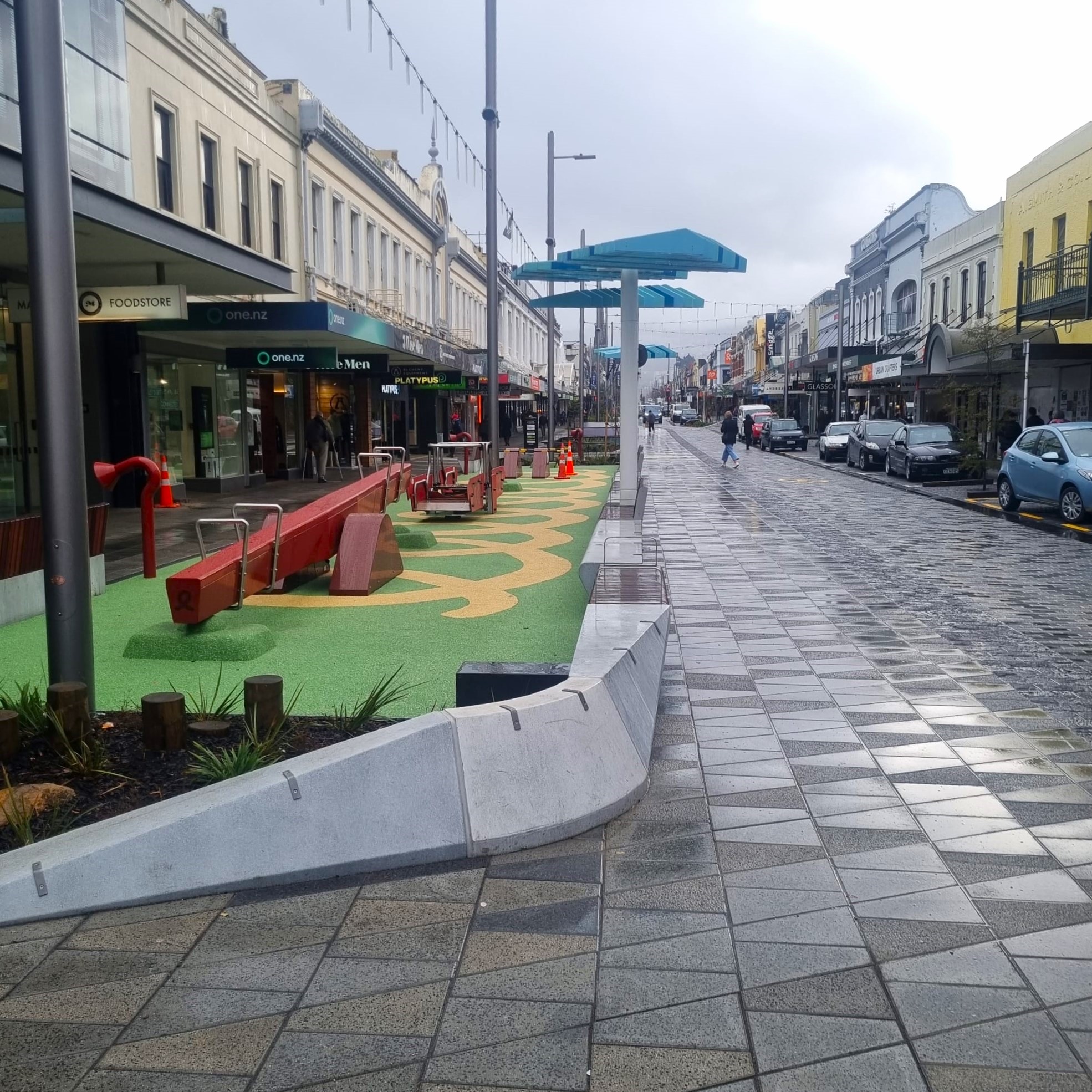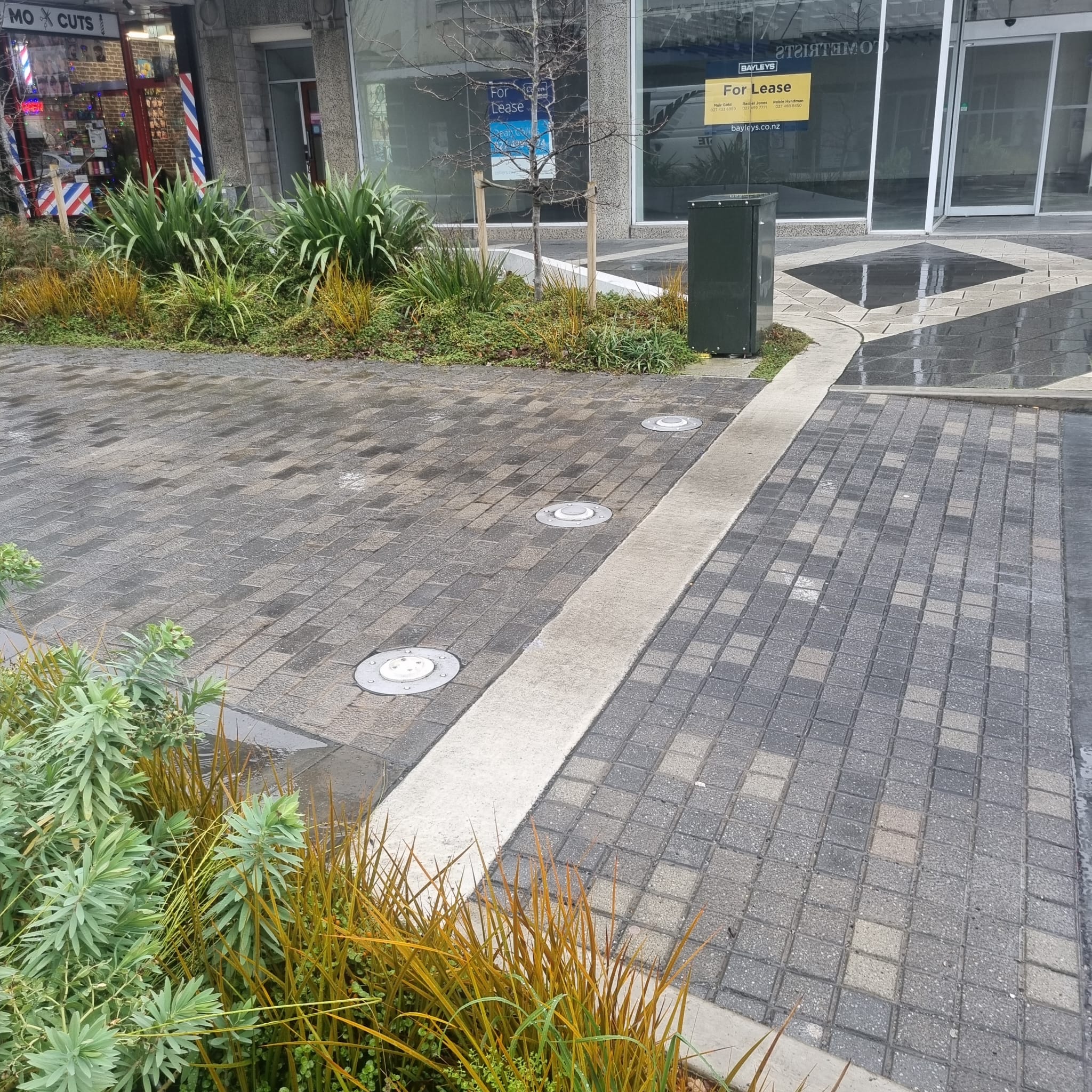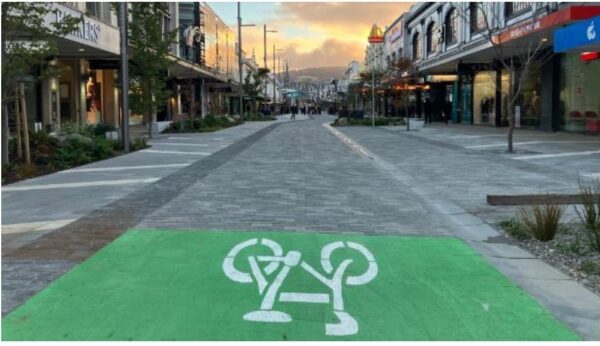The revitalisation of Auckland city centre, especially around Wynyard Quarter, Te Komititanga, and Queen Street, is top of mind for Greater Auckland readers – but other cities around Aotearoa New Zealandare installing people-friendly streets. This guest post by Jessica de Heij, who grew up in the Netherlands and is an advocate for 15-minute cities, highlights recent transformations in Dunedin and Invercargill.
Great streets and cities are not effortlessly achieved – they require effort and great, visionary leadership. We have seen this overseas through the likes of Anne Hidalgo (Paris) and Janette Sadik Khan (New York) etc. In Auckland, transformations were led by the ADO (Auckland Design Office).
Here in Dunedin, if it weren’t for the determination and visionary leadership of the previous Mayor, Aaron Hawkins, we couldn’t have achieved the new and revitalised George Street, aka Totally Georgeous, and sign-off of the cycle route along the harbour. Both are world-class infrastructure projects that provide great connections for the community and actual transport choices for people that can’t drive or prefer another mode of transport.
Absolutely Positively George St
The revitalisation of George Street covers 3 blocks – New Edinburgh Way block (between Hannover and Frederick St), the Malls block (between Hannover and St. Andrew St) and Farmers block (between Frederick and Moray Place), plus some surrounding streets.

Officially opened in May this year, the George Street makeover entails 600m of walkable streets, which are one-way for traffic and attractively paved with wide footpaths, really showing that the car is really a guest here. Besides the footpath, there is also a shared path running along the road to give more space for people on bikes. Rain gardens have been implemented to deal with stormwater, and the icing on the cake has been the playground (just near the entrance of the Mall) that really activates the whole space.

Another great feature – and which might be a first in Aotearoa – are the retracting bollards that have been installed at the entrance of every block. These have been deployed for public events and university graduations, occasions when the Council would want to transform the street into a car-free, people-friendly space.

Invercargill’s transformation
Another southern city, Invercargill, with the help of its Council put together a masterplan to create a walkable city centre that attracts more people. The public consultation showed enthusiasm for creating a vibrant city centre, and support for preserving heritage – but with a narrowed focus on certain buildings as recommended by heritage consultants. (Invercargill is very rich in historic buildings, but they are a challenge to maintain and bring up to seismic standard).


This is Invercargill’s brand new shopping mall. Most malls in cities, at least those away from the city centre, are on main arterials easily accessible by car, eg. St. Lukes Westfield. The Invercargill mall isn’t a standard suburban mall, but is more designed towards the Dutch concept: it’s in the middle of the city centre, easily accessible for anyone.
It’s also future-proofed for greater access, being in the perfect location if the government decides to restore the Southerner train line (Christchurch-Invercargill).

Invercargill Central is also a mall that would easily fit into a European city, rather than an American one. Comparable to Commercial Bay at Britomart, it features wide open spaces, little boutique stores and a wide range of eateries with indoor and outdoor dining.



The combination of brick, timber, high ceilings and lighting makes it a really great experience to visit.

Esk Street & Don Street
Esk St is the main high street in Invercargill. Iust like George St. in Dunedin, it’s been transformed into a one-way street paved at the same level from one side to the other. Like George St, Esk St features wide footpaths, lots of benches, greenery and bike parking. Don Street is behind it, and has a similar vibe, the main difference being that it’s a two-way road with asphalt surface; it has some more eateries and a few offices.
One thing missing is bollards to prevent illegal parking (likewise on George Street in Dunedin), despite them being by far the best solution as we see overseas and on Te Komititanga in Auckland which remains car-free because it is ringed with bollards. Bollards are a key element in the walkable city toolbox: they reduce illegal parking, enhance pedestrian safety, promote walkability and protect greenspace.
The main difference with Invercargill is that almost every metre of space between the footpath and road space has been covered by either greenery, benches, art structures or bike stands (essentially functioning as bollards). This means it’s very hard for drivers to illegally park on any part of the two walkable streets in Invercargill. Although people still try….


Another advantage of the Invercargill strategy is that it makes the street narrower (or at least gives the visual illusion that it’s narrower) which slows down through-traffic.
Compare this with George Street in Dunedin which has a similar design, but fewer objects on the street to divide the shared space. This allows for illegal parking and leaves the street trees unprotected. And, because the street looks wider, drivers are still speeding on George Street. The official speed limit is 10km/h, but unfortunately to my eye the majority are still driving 30-40kmh, with extremes of 50kmh.

Another great feature of the Invercargill design is the raised tables. These are properly built, and it is almost impossible to go over them over 30km/h even with utes or SUV’s. See the video below which really shows how much drivers need to slow down in order to go over the raised table. This helps reduce overall speeds on the street, which makes for a safer environment for everyone.
Overall, it’s great to see these walkable streets being implemented all over Aotearoa. Not only do they make it easier for people to get around their city, they also contribute to various positive outcomes.They help reduce emissions; foster social cohesion, which can lead to improved mental well-being; reduce speeds, resulting in fewer accidents; and attract more people, including visitors and tourists, as well as more businesses and further investment.
Header image: Don St, Invercargill, on a beautiful southern day.

 Processing...
Processing...
It seems a shame,that a lot of planning and expense is required to stop vehicle drivers from invading a space not intended for their use. We could have even better spaces if the drivers respected the intent.
These places all look considerably nicer than when I last might have seen them, perhaps a decade ago. As does our city centre, in comparison.
Cars are still enemy number one however, and until we have a decisive leader who is willing to physically stand in front of an SUV and play chicken, then vehicles will only continue to increase in size; and by then what differentiates us from UKRAINE???
bah humbug
“Invercargill Central is also a mall that would easily fit into a European city, rather than an American one”
Invercargill Central is a US style mall through and though, its core is a multistory 650 space carpark off a main arterial route (Tay street,) -That’s one space for every 90 people in Invercargill)
– its face might open onto a pedestrianised street on one side, but its back side is pure car-centric consumerism,
https://www.invercargillcentral.nz/parking
Your enthusiasm for the cause is commendable, but please be realistic. Many, probably the majority of shoppers at that mall will drive in from places where there are no public transport options.
My thoughts exactly. Palmerston North has had a central city mall for 40 years, with a large expansion in 2010. It has 1200 car parks. It hasn’t stemmed the decline of the rest of the central city. So it will be interesting to see if the semi-pedestrianised street in Invercargill can make a difference.
I don’t think this is fair. When I think “US style mall”, it’s in the suburbs in the middle of a sea of asphalt that separates it from the surrounding community, where free surface parking is provided. Access is pretty much restricted to vehicles.
Compare what Invercargill Central looks like compared to “Golden Triangle Mall, Denton” or “Lakeview Square Mall, Battle Creek” on Google Maps.
While it would be great to see more of this thinking in the heart of Auckland, we could give more attention to secondary centres such as Takapuna. There’s almost no reason for there to be car traffic on Hurstmere Road to take an obvious example. A similar case can be made in most neighbourhood hubs around Auckland.
Yeah, local centres like Parnell, Newmarket, Birkenhead, Glenfield, Onehunga, Ponsonby would all deserve that. Unfortunately some of them are around main arterials that are hard to get rid off.
Agree. Onehunga make would be great going back to be a ped mall. Times have changed since it was last a ped mall Way more intensification there. Cars should go around the edges and park in the side car parks nearby.
Sadly in Onehunga there is a very loud contingent who can claim “but we tried making Onehunga a pedestrian mall and it failed”
I’m convinced the shops were failing due to car dominance and people moving to the further out suburbs and shopping at the big supermarkets and malls, the pedestrianisation was a valiant effort to make Onehunga nicer but the people were already finished shopping there.
They brought the cars back but many of the shops have really struggled despite that. Dressmart helped bring some business back. It’s really revitalizing now with the abundance of apartment living in walking distance, so I reckon time to get rid of the cars again. But will be very hard to dislodge that memory.
Interesting, didn’t know they had tried that. These things are often blamed on bus or cycle lanes etc, but often it’s other factors already at play.
that was a long time ago. I lived there 20 years ago and had no idea it had ever been pedestrianised until I read it here.
Please ignore the retired folk and build for the future.
It’s really good to see ideas used in Auckland being taken and improved on elsewhere. Dunedin and Invercargill both deserve these better environments. I hope that the rising bollards can be used often enough to get the street back for people in Dunedin – good for the long walk to Forsyth-Barr Stadium.
Invercargill’s mall appears to have better indoor-outdoor flow than many. Liverpool and Bradford in UK have lots of glazed street frontage blanked of without street doors and with advert screening. It’s hard for planners anywhere to get mall owners to respect the town centres that they rely on for customers, rather than ‘lock them in so they can’t escape’.
Don’t be too hard on Tay Street – it is after all SH1, the nation’s main highway, carrying all the traffic between The World and Bluff.
Looks good. Great post thanks. Nothing beats a good bollard in the right place.
The Bollards on George St don’t currently work. One of my colleagues went out to test them last week with a couple of DCC staff members. We had to use cones & road closed signs when we closed George St for the city activation for All Blacks vs England on Saturday night. There are no plans to ever use the bollards for graduation parades. BTW, I work at Dunedin’s largest traffic management company as one of the planners, we design & implement the majority of DCC’s event road closures.
So, fix the bollards please !
That’s up to DCC, not the company I work for.
I typed that reply without properly thinking it through. It’s up to Isaac Construction to fix the bollards, they installed them for DCC as part of the George St project. The company I work for is a purely temporary traffic management company, we had absolutely no involvement in the design or installation of the bollards.
Nice photos of shiny new streets makeover, but as noted by others, these cities are also regional service centres – most people need to drive to go shopping – parking is needed. That’s not my major issue however, it is the lack of colour in the chilly south. Dunedin trashed the former warm-coloured red brick paving for shades of cold grey, Invercargill has opted for greys as well. The architects are obviously afraid of colour and have drunk the b&w and grey coolade. Looks drab and cold – not what’s needed in the south of New Zealand.
Seems there is parking:
https://www.parkopedia.co.nz/parking/locations/dunedin_otago_new_zealand_j8g4pzc5pbvn5hyab7/
There is always ample parking, as well as access at certain times for service vehicles.
But pedestrianise just one single street and apparently cars and parking are banned across the city.
The red bricks were dangerous when wet. There is lots of colour in the rain gardens.
I’d add to my earlier post, that Invercargill has added some red/brown tone bricks, so positive marks for them, much better effort than Dunedin. Overall though, the impression in daytime photos is that it is cold and drab – the reality of both cities in winter.
I’d agree red/brown tone bricks, would have been lovely, but I’d imagine there has been a lot of compromises on both of these projects, so it’s great to see this end result.
It’s not perfect, but a welcome end result.
Thanks for writing such an inspiring piece, I look forward to seeing these areas in person one day. Having visited Rotorua and Taupo recently, these are also looking much more beautiful and inviting for people – change is never easy, but it is taking place.
The retractable bollards aren’t a first – there are three sets for Te Komitanga Square in Auckland. Entrances on Tyler St, Galway St and Quay St.
I don’t understand the need to still have cars pass through those streets. It should be delivery/emergency only.
As a former Central Otago resident I am incredibly happy of the changes in Dunedian & Invers. I’ve got the opportunity to see the pedestrinisation in Queenstown too! Great job Jessica!
Great to see what’s going on in Dunedin! Thanks Jessica 🙂